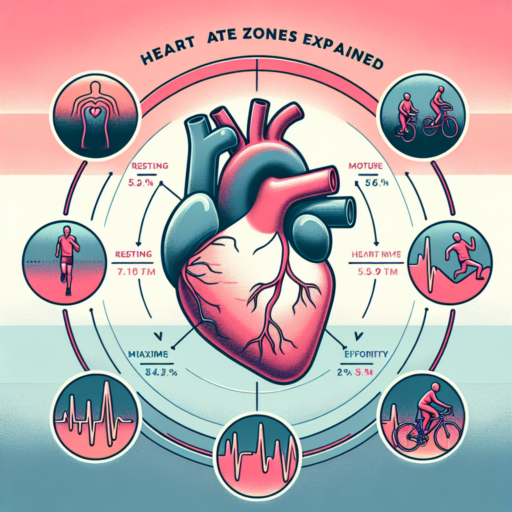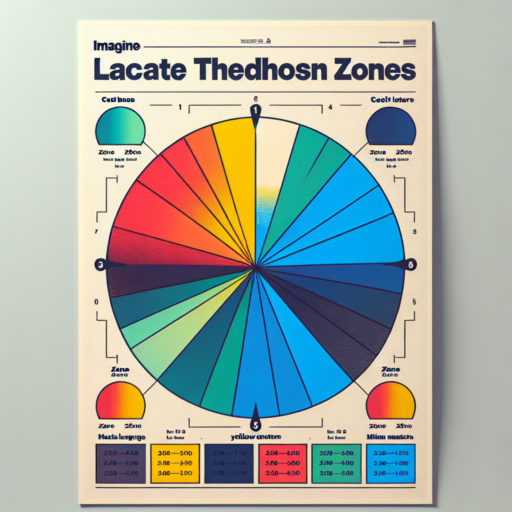Understanding Heart Rate Zones: A Comprehensive Guide
Understanding your heart rate zones is pivotal for maximizing your workout efficiency, whether you’re an avid athlete or just stepping into the world of fitness. Heart rate zones are specific ranges your heart rate (measured in beats per minute) can fall into, each offering unique benefits for your health and training goals. By knowing which zone you’re exercising in, you can tailor your workout to focus on fat burning, endurance, or high-intensity interval training (HIIT).
Breaking Down the Five Heart Rate Zones
Typically, heart rate zones are divided into five categories. Zone 1 is the lowest intensity, often referred to as the ‘fat-burning zone,’ ideal for beginners or for recovery days. As you move up to Zone 2, you enter the ‘endurance zone,’ which is great for building aerobic capacity. Zone 3 marks the ‘moderate intensity’ zone, where you’re working harder but can still hold a conversation. The fourth zone is where the high-intensity begins, pushing your anaerobic threshold and improving your speed and strength. Finally, Zone 5 is the peak of intensity, which is unsustainable for long periods but is excellent for short, sharp bursts of effort and improving maximum power output.
How to Determine Your Heart Rate Zones
To calculate your personal heart rate zones, you first need to know your maximum heart rate (MHR). A common method to estimate this is by subtracting your age from 220. With your MHR in hand, you can then apply it to the percentages that define each zone. For example, Zone 1 might be 50-60% of your MHR, while Zone 5 could be 90-100%. Remember, these calculations are estimates and can vary based on fitness level, genetics, and overall health.
Integrating heart rate zone training into your fitness regimen can drastically improve your physical performance and health outcomes. By focusing on specific zones, you can ensure that every workout is structured with a purpose, whether that’s improving cardiovascular health, endurance, or strength. Moreover, this method of training encourages a more mindful approach to exercise, letting you tune into how your body feels and responds during different kinds of physical activity.
The Science Behind Heart Rate Zones and How They Affect Your Workout
Understanding your heart rate zones is crucial for maximizing the efficiency of your workouts. These zones, which are percentages of your maximum heart rate, guide you in training at intensity levels that are conducive to achieving specific fitness goals. From improving cardiovascular health to enhancing fat burning, each zone offers different benefits and is calculated based on the intensity of physical activity in relation to your heart’s capabilities.
Determining Your Heart Rate Zones
To accurately apply heart rate zones to your workout regimen, it’s essential to first determine your maximum heart rate. This can typically be calculated with the formula: 220 minus your age. With this data, you can then define your specific heart rate zones, which generally break down into five categories: very light, light, moderate, hard, and maximum effort. These zones are reflective of the intensity of exercise and the corresponding percentage of your maximum heart rate.
Within these zones, your body reacts differently. For instance, training in the ‘moderate’ zone, which is about 50-70% of your maximum heart rate, is excellent for enhancing aerobic capacity and endurance. Whereas the ‘hard’ zone, around 70-85% of your maximum heart rate, pushes your body to improve its cardiovascular and respiratory efficiency, translating to improved oxygen consumption and stamina. Each zone serves a unique purpose, contributing to various aspects of physical fitness and overall health.
Implementing Heart Rate Zone Training
Incorporating heart rate zone training into your workout strategy not only helps in better managing your exercise intensity but also in tracking your progress. By understanding and utilizing these zones, athletes and fitness enthusiasts can tailor their workouts to focus on burning fat, improving heart health, or increasing speed and strength. This strategic approach enables a more personalized workout plan, ensuring that every session is aligned with your fitness goals and capabilities, thereby enhancing the overall effectiveness of your training routine.
Calculating Your Personal Heart Rate Zones: A Step-by-Step Tutorial
Understanding and calculating your personal heart rate zones is a cornerstone of tailoring your fitness journey to meet your specific goals, whether it be improving cardiovascular health, boosting endurance, or optimizing fat loss. This step-by-step tutorial will guide you through the process of determining these crucial thresholds, empowering you to train more effectively.
Why Your Heart Rate Zones Matter
Your heart rate zones are pivotal in identifying the intensity of your workouts. Each zone reflects a percentage of your maximum heart rate (MHR) and corresponds to different intensity levels and benefits. For instance, training in lower zones is ideal for fat burning and endurance building, while higher zones are best suited for improving aerobic and anaerobic capacity. By training in your specific heart rate zones, you can ensure each workout is as efficient as possible, tailored to your specific fitness objectives.
Identifying Your Maximum Heart Rate (MHR)
The first step in calculating your heart rate zones is to establish your Maximum Heart Rate (MHR). A popular method for estimating your MHR is by using the formula 220 minus your age. Though this method provides a general approximation, be mindful that individual variances can affect accuracy. For a more precise measurement, consider conducting a supervised stress test with a fitness professional.
No se han encontrado productos.
Maximizing Fitness Results Through Targeted Heart Rate Zone Training
Understanding and applying the concept of targeted heart rate zone training is crucial for those looking to maximize their fitness results efficiently. By exercising within specific heart rate zones, individuals can optimize fat burning, improve cardiovascular health, and enhance athletic performance. This method taps into the science of how your body utilizes energy differently at various intensity levels, ensuring that every workout is aligned with your fitness goals.
Identifying Your Target Heart Rate Zones
Identifying your personal target heart rate zones involves calculating your maximum heart rate and applying percentages to determine the appropriate intensity levels for your workouts. Generally, these zones are divided into light, moderate, and vigorous intensity, each serving different training purposes. For instance, training in your moderate-intensity zone can be ideal for endurance building, while high-intensity zones are beneficial for improving speed and power.
Benefits of Training in Your Target Heart Rate Zone
One of the key benefits of targeted heart rate zone training is its ability to personalize your workout regimen. By understanding and staying within your specific zone, you can avoid overtraining and reduce the risk of injury. Additionally, this method promotes more efficient calorie burn and fat utilization, helping you achieve your weight loss or body composition objectives sooner. Moreover, athletes find that heart rate zone training enhances performance by allowing for focused improvements in both aerobic and anaerobic capacities.
Heart Rate Zones Explained: From Fat Burning to Peak Performance
Understanding your heart rate zones is crucial for optimizing your workout, whether you’re aiming to lose weight, improve cardiovascular health, or reach your peak athletic performance. These zones are based on percentages of your maximum heart rate (MHR), with each range serving a different purpose in your fitness regimen. By identifying and training within these zones, you can tailor your exercise program to meet your specific goals more efficiently.
In the realm of fitness, the concept of heart rate zones
divides your effort into categories. Generally, these are segmented as fat burn, cardio, and peak performance zones. The fat burning zone occurs at 50-70% of your MHR, a relatively low-intensity level where the body primarily uses fat for energy. Conversely, training in the peak performance zone, which is about 85-100% of your MHR, shifts the body’s fuel source towards carbohydrates and significantly improves aerobic and anaerobic fitness.
Between these two extremes lies the cardio or aerobic zone (70-85% of MHR), ideal for improving cardiovascular health and stamina. Training in this zone increases your heart and lung capacity, allowing for oxygen to be more efficiently utilized during intense workouts. Emphasizing different zones within your exercise routine can lead to a more balanced, comprehensive fitness strategy, ensuring that you’re not just burning calories but improving your overall health and athletic capability.
The Relationship Between Heart Rate Zones and Cardiovascular Health
Comprehending the link between heart rate zones and cardiovascular health is essential for devising effective fitness routines. These zones, identified through various exercise intensities, allow individuals to tailor their workout sessions to optimize heart health. Knowing which zone you’re in can serve as a guide to ensuring your cardiovascular system is engaged adequately, not undertrained or overexerted.
Understanding Heart Rate Zones
Heart rate zones are typically divided into five categories, each representing a specific percentage of your maximum heart rate (MHR). These zones range from the very light intensity of Zone 1, ideal for warm-ups and cool-downs, to the high intensity of Zone 5, where exercise is performed at 90-100% of your MHR. Training in different zones has distinct effects on the cardiovascular system, influencing everything from endurance building to the improvement of aerobic capacity.
Benefits of Heart Rate Zone Training
- Enhanced Cardiovascular Fitness: Regularly exercising in Zone 2 and Zone 3 can significantly improve cardiorespiratory endurance, enhancing overall heart health.
- Optimal Fat Burning: Targeting Zone 2 for longer durations encourages the body to utilize fat as its primary energy source, promoting healthy weight management.
- Improved Aerobic Capacity: Working out in Zone 4 increases aerobic capacity, which means the heart pumps more efficiently, distributing oxygen to the muscles more effectively.
The interplay between heart rate zones and cardiovascular health is a pivotal aspect of developing a balanced and effective training regimen. Leveraging this knowledge allows for a more scientific approach to exercise, maximizing benefits while minimizing risks. By focusing on heart rate zone training, individuals can ensure their workout efforts are precisely aligned with their health goals, especially those related to cardiovascular fitness.
How to Use Heart Rate Zones to Enhance Your Exercise Routine
Understanding and utilizing heart rate zones can significantly optimize your exercise routine for better fitness outcomes. Each heart rate zone targets different fitness goals, from burning fat to improving cardio endurance. By customizing your workout plan around these zones, you can ensure you’re exercising effectively and efficiently.
Identify Your Maximum Heart Rate
The first step to using heart rate zones is to identify your maximum heart rate (MHR). A general formula for this is subtracting your age from 220. This gives you a baseline to determine your optimal heart rate zones, which are expressed as percentages of your MHR. Knowing your MHR allows you to tailor your workout intensity based on your fitness objectives.
Understanding the Five Heart Rate Zones
Zone 1 (50-60% of MHR): This is the very light intensity zone, ideal for warming up and cooling down. Exercises in this zone help with recovery and fat burning.
Zone 2 (60-70% of MHR): Known as the fat-burning zone. Training in this zone is great for building endurance and further enhancing fat loss.
Zone 3 (70-80% of MHR): This is the aerobic zone, improving cardiovascular fitness and aerobic capacity.
Zone 4 (80-90% of MHR): Training in this zone increases anaerobic capacity and speed. It’s where you improve your ability to push your pace.
Zone 5 (90-100% of MHR): This is the peak performance zone, enhancing speed and power. It’s suitable for short, intense bursts of exercise.
Incorporating these heart rate zones into your training schedule allows you to focus your efforts where they are most effective for your personal fitness goals. By varying your training across different zones, you can improve your overall fitness, endurance, and strength more efficiently.
Common Myths About Heart Rate Zones Debunked
When it comes to understanding heart rate zones, the fitness world is awash with misinformation and myths that can confuse even the most diligent of athletes. Discussing these misconceptions is crucial not only for improving workout efficiency but also for safeguarding one’s health. In this exploration of common myths about heart rate zones, we intend to shed light on and clarify these misleading beliefs to aid in your fitness journey.
One prevalent myth is that staying in the ‘fat-burning zone’ is the best strategy for weight loss. This oversimplification ignores the complexity of human metabolism and the benefits of training in various heart rate zones. While it’s true that lower intensity exercises target fat as a primary fuel source, the total amount of calories burned matters more for weight loss than the specific type of energy consumed during exercise. Therefore, blending workouts across all heart rate zones may offer more substantial overall benefits for fat reduction.
Another widespread falsehood is the belief that a high heart rate is inherently dangerous and indicative of over-exertion. While it’s essential to be mindful of your body’s signals and understand your personal limits, a high heart rate during exercise is not universally negative. It reflects the body’s natural adaptation to increased physical demands and, with proper conditioning and rest, can improve cardiovascular fitness and endurance. Recognizing the difference between pushing your limits healthily and overtraining is key to leveraging high heart rate zones effectively.
Lastly, the notion that one must always train in a specific heart rate zone to see results is another myth that needs addressing. Fitness is multifaceted, involving strength, endurance, flexibility, and balance. Diversifying your training to include exercises targeting different heart rate zones can enhance overall fitness and performance rather than adhering strictly to a single zone. This holistic approach prevents plateaus, reduces the risk of injury, and keeps workout routines engaging and sustainable.
Tools and Apps for Monitoring and Staying Within Your Heart Rate Zones
Understanding and staying within your heart rate zones is a pivotal aspect of maximizing your workouts and ensuring your heart health. With the advancement of technology, a multitude of tools and apps have emerged, designed specifically to assist individuals in monitoring their heart rate zones effectively. These digital aids range from wearable technology to smartphone applications, each offering unique features to cater to the varying needs of fitness enthusiasts and health-conscious individuals alike.
Among the plethora of options, wearable devices such as fitness trackers and smartwatches stand out for their convenience and real-time monitoring capabilities. Brands like Fitbit, Garmin, and Apple Watch have become synonymous with heart rate monitoring, providing users with continuous data on their heart rate zones. These devices not only track your heart rate during workouts but also keep an eye on your resting heart rate, offering a comprehensive overview of your heart health.
On the other hand, smartphone applications are a highly accessible alternative for those who may not prefer wearable tech. Apps such as MyFitnessPal, Strava, and MapMyRun integrate heart rate data from external devices or manually entered information to give feedback on your heart rate zones. These apps often include features such as personalized training plans and analytical breakdowns of your workouts, making it easier to stay motivated and informed about your heart health.
Success Stories: Real-Life Benefits of Applying Heart Rate Zone Training
Exploring the world of fitness and exercise, heart rate zone training emerges as a vital component for achieving workout goals efficiently. This method allows individuals to structure their workout intensity based on heart rate zones, letting them tap into fat burning, endurance, and peak performance thresholds effectively. The real-life benefits of heart rate zone training are illustrated through numerous success stories, shed light on its efficacy and transformative impacts.
Maximizing Fat Burning – Many fitness enthusiasts have shared how heart rate zone training revolutionized their weight loss journeys. By targeting specific heart rate zones, these individuals were able to maximize fat burning during their workouts. This focused approach to exercise, guided by heart rate data, enabled a more scientific step towards weight loss, producing remarkable results in body composition changes.
Enhancing Athletic Performance – Athletes across various disciplines attribute significant improvements in their performance to heart rate zone training. By identifying and training within their ideal heart rate zones, athletes have honed their bodies to operate at peak efficiency during competitions. Success stories often highlight the role of data-driven workout plans in achieving personal bests and surpassing performance plateaus.




